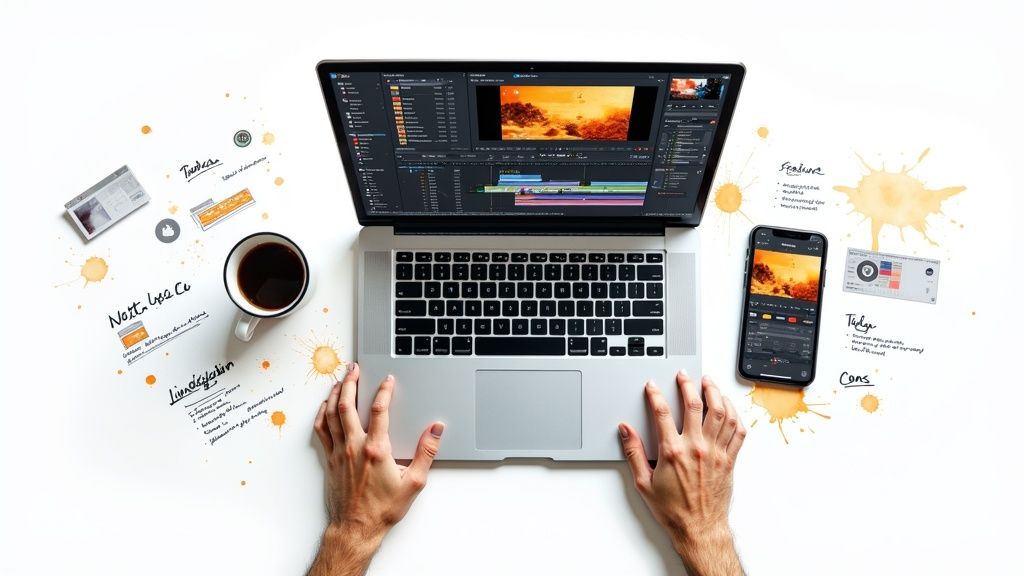In This Article
Subscribe to our newsletter
The Evolution of Video Content Strategy

Video content has rapidly become essential for marketing. It's no longer a supplemental element, but a core component of any successful strategy. This shift reflects a fundamental change in how businesses interact with their audience. Remember when a static image and compelling text were enough? Today's consumers want dynamic and engaging experiences, and video delivers that better than any other medium. This means businesses need to adapt their video strategies to stay competitive.
The Rise of Video in the Digital Age
Several key market shifts have driven this evolution. The rise of mobile devices and faster internet speeds make watching videos on the go incredibly easy. Social media platforms like TikTok TikTok and Instagram Instagram also prioritize video. Features like live streams, short-form videos, and stories have further solidified video's place in online engagement. This has propelled video from the sidelines to the center of marketing efforts.
The rise of easy-to-use video creation tools has also been a game-changer. Creating high-quality video used to require expensive equipment and specialized expertise. Now, user-friendly software like Adobe Premiere Pro Adobe Premiere Pro makes video production accessible to businesses of all sizes. This accessibility has leveled the playing field, allowing smaller businesses to compete effectively with larger corporations in the video marketing space.
Let's take a look at the growth of video marketing adoption. To illustrate the shift, let's examine some key statistics demonstrating the increasing adoption of video marketing by businesses and the corresponding demand from consumers. In 2016, only 61% of businesses used video. By 2023, this number jumped to 91%, with video becoming a cornerstone of digital marketing. Find more detailed statistics here.
To further highlight this growth, let's look at the data in a more structured way:
The following table shows the adoption of video content over time. It compares the percentage of businesses using video with the corresponding consumer demand.
Video Content Adoption Over TimeComparison of business video adoption rates and viewer preferences
| Year | Businesses Using Video | Consumer Demand |
|---|---|---|
| 2016 | 61% | - |
| 2023 | 91% | 54% want more video |
This table clearly shows the dramatic increase in video usage by businesses, reflecting the growing consumer appetite for video content. The fact that 54% of viewers want more video from businesses they follow speaks volumes about the power of this medium.
Capitalizing on Changing Engagement Patterns
Forward-thinking companies are capitalizing on these shifts in how audiences engage with content. They're moving beyond simple product demonstrations and creating narratives that connect with their target audience on an emotional level. Video offers a powerful way to build these connections, fostering trust and loyalty.
Effective video content strategies rely on a deep understanding of the target audience. This involves knowing not just what they want to watch, but also where and how they consume video content. This understanding is key for creating content that truly resonates and achieves its purpose, whether that’s driving website traffic, generating leads, or boosting sales. This requires businesses to continually analyze data, track trends, and adapt their strategies to stay ahead of the curve.
Building Your Video Content Strategy Framework
Creating engaging videos is only half the battle. A robust video content strategy is essential for guiding your efforts and ensuring measurable results. Without a solid strategy, even visually appealing videos may not reach their full potential. This section explores how successful brands develop video strategies and provides a framework you can adapt to your own needs.
Defining Clear Objectives and Aligning with Business Goals
Every video content strategy needs a clear purpose. Ask yourself what you want to achieve with your videos. Are you looking to increase brand awareness, drive website traffic, generate leads, or boost sales? These objectives should align directly with your overall business goals. For example, if increasing market share is a business goal, your video strategy might focus on building brand authority and highlighting your product's unique value.
Understanding Your Audience Through Thorough Research
A successful video content strategy hinges on understanding your audience. This involves going beyond demographics and exploring their preferences, habits, and pain points. Consider where they consume video content, what type of content resonates with them, and what questions they have. This research will inform your content decisions and ensure you create videos your audience wants to watch.
Building a Sustainable Video Production Process
Creating a sustainable video production process is crucial for long-term success. This involves establishing workflows that align with your resources, whether you're a solo creator or part of a larger team. Consider your budget, equipment, and personnel. Defining roles, setting deadlines, and establishing quality control measures are all key components. You might find value in resources like How to master video creation for social media.
Maintaining Brand Consistency Across Platforms
While adapting your message to different platforms is important, maintaining brand consistency is equally crucial. Your videos should maintain a consistent look and feel regardless of where they are published. This includes using consistent branding elements like logos, colors, and fonts, as well as maintaining a consistent tone and style. Consistency strengthens brand recognition and builds trust with your audience.
Overcoming Common Video Strategy Roadblocks
Many video initiatives struggle due to common roadblocks. One major obstacle is the lack of clear metrics. Without defined key performance indicators (KPIs), it's hard to measure success and identify areas for improvement. Inconsistent content creation and failing to adapt to platform-specific best practices are other challenges that can limit reach and engagement.
To summarize the key elements of a successful video content strategy, the following table offers a helpful overview:
To better understand the core components of a successful video content strategy, let's look at the table below. It summarizes the key elements and provides practical tips for implementation.
Video Content Strategy ComponentsKey elements required for a comprehensive video strategy
| Component | Purpose | Implementation Tips |
|---|---|---|
| Clear Objectives | Define what you want to achieve with your videos | Align with business goals; Use SMART goals |
| Audience Research | Understand your target audience's preferences and needs | Conduct surveys, analyze social media data, monitor industry trends |
| Sustainable Production | Establish efficient and manageable workflows | Define roles, set deadlines, use resources effectively |
| Brand Consistency | Maintain a unified brand identity across platforms | Use consistent branding elements, adapt messaging while keeping core values |
| Performance Measurement | Track and analyze video performance to optimize strategy | Define KPIs, monitor analytics, adapt based on data insights |
By addressing these components and overcoming common challenges, you can create a powerful video content strategy that delivers tangible results. This structured approach ensures that your video efforts contribute significantly to your overall marketing objectives and maximize your return on investment.
Platform-Specific Video Content Strategies

A successful video content strategy hinges on understanding your audience's online habits. Different platforms attract different demographics and foster unique content styles. A blanket approach won't cut it. Tailoring your content is essential for maximizing engagement and expanding your reach.
YouTube: The Reign of Long-Form
YouTube reigns supreme in video marketing thanks to its enormous user base and powerful search capabilities. Boasting over 2.3 billion monthly logged-in users, it’s a primary source for both information and entertainment. In the U.S., 90% of people prefer YouTube for digital video consumption. Find more detailed statistics here. This makes YouTube the perfect platform for long-form content, tutorials, and detailed discussions. Effective strategies often involve keyword research, optimized titles and descriptions, and a regular posting schedule.
TikTok and Instagram Reels: Short and Sweet
TikTok and Instagram Reels thrive on short, captivating videos. Trends, challenges, and visually appealing content are king. A winning strategy here prioritizes creativity, quick cuts, and trending audio. Content should be concise, grabbing attention immediately. This contrasts sharply with YouTube's preference for longer, more detailed videos.
LinkedIn: For the Professional
LinkedIn is the hub for professional networking. Video content should focus on thought leadership, industry insights, and career development. Sharing your expertise, engaging in industry dialogues, and connecting with other professionals are crucial for success on LinkedIn. The tone should be more formal and informative than on other platforms.
Facebook: Building Your Community
Facebook is all about community. Video content that sparks interaction and conversation performs best. Sharing behind-the-scenes looks, hosting live Q&As, and telling compelling brand stories can cultivate a loyal following. Authenticity and connection are essential elements of a strong Facebook video strategy.
Optimizing Video Length and Format
Just as content style varies, so does ideal video length. A 10-minute tutorial might excel on YouTube, while a 60-second version could perform better on TikTok. Aspect ratios also play a role. YouTube generally prefers 16:9 widescreen, while TikTok and Instagram Reels favor 9:16 vertical video.
Engagement Tactics: Platform by Platform
Different platforms demand different engagement tactics. Encouraging comments and subscriptions is vital on YouTube. On TikTok and Instagram Reels, using trending hashtags and participating in challenges can boost visibility. For LinkedIn, engaging in discussions and offering valuable insights strengthens your network. On Facebook, asking questions, responding to comments, and fostering a sense of community are effective strategies. Adapting your approach to each platform is key to maximizing impact and achieving your video marketing objectives.
Creating Video Content That Converts

A successful video content strategy goes beyond superficial metrics like views and likes. It prioritizes conversions, meaning the focus is on creating videos that encourage viewers to take specific actions. Let's explore how to transform passive viewers into actively engaged customers.
Hooking Viewers in the First Eight Seconds
Attention spans are short. You have a limited window to capture viewer interest. Make those first eight seconds count by crafting compelling introductions. Think about starting with a thought-provoking question, a surprising statistic, or a visually captivating scene. The key is to create a hook that keeps viewers watching.
Messaging That Resonates With Audience Pain Points
Effective video content speaks directly to the needs and challenges of your target audience. By understanding their pain points, you can create videos that offer solutions and build a stronger connection. Thorough audience research is essential. This helps you identify their struggles and aspirations. For example, if your audience grapples with time management, videos offering practical time-saving tips will likely resonate.
Strategic Calls to Action That Drive Desired Actions
A clear and compelling call to action (CTA) is crucial for driving conversions. Tell viewers exactly what you want them to do. This might be visiting your website, subscribing to a newsletter, or making a purchase. The placement and wording of your CTA matter. Position it prominently within the video and use action-oriented language. This encourages viewers to take the next step. For more information on video ad creation, check out this helpful guide: How to master video ad creation.
Matching Video Types to the Buyer's Journey
Different video types serve various purposes throughout the buyer's journey. In the awareness stage, explainer videos and educational content introduce your brand and build trust. During the consideration stage, product demos and testimonials help viewers evaluate options. Finally, in the decision stage, customer success stories and special offers can encourage conversions.
Balancing Entertainment and Conversion Mechanics
While conversions are key, remember the importance of entertainment. Engaging and enjoyable videos are more likely to be shared and remembered. Finding the right balance between entertainment and conversion tactics is crucial for sustained success. This requires understanding your audience and their preferences.
A strong video content strategy focuses on tangible results. The financial benefits of video marketing are significant. Businesses using video often see improved ROI. Video can increase website conversions by up to 80% and boost site viewing time by 88%. Furthermore, video content can outperform image ads by three to five times. Explore this topic further. This demonstrates the power of video marketing to generate impressive returns. By implementing these strategies, you can create videos that not only attract viewers but also drive meaningful business outcomes.
Production Strategies That Won't Break the Bank
Creating high-quality video content doesn't have to deplete your resources. A well-planned video content strategy incorporates efficient production. Smart creators know how to produce engaging content while minimizing expenses. Let's explore some budget-friendly strategies for professional results without overspending.
Maximizing Existing Equipment and Resources
Before investing in new equipment, assess what you already have. Your smartphone's camera, for example, can capture surprisingly high-quality footage. Pair this with readily available, often free, video editing software like DaVinci Resolve, and you have a basic video production setup. Many smartphones offer 4K recording capabilities, potentially eliminating the need for a dedicated camera.
Lighting and Audio on a Budget
Professional lighting and audio equipment can be expensive. However, there are cost-effective alternatives. Natural light, used strategically, can be an excellent light source. Positioning your subject near a window, for instance, can create soft, appealing lighting. For audio, a simple lavalier microphone, often available for under $20, can drastically improve sound quality compared to using the built-in microphone.
Accessible Editing Tools for Polished Results
Several free or low-cost video editing tools offer various features for creating polished videos. These tools often include basic color correction, transitions, and title options, making professional-looking videos achievable even on a tight budget. Numerous online tutorials and resources can help you quickly master these tools.
Workflow Efficiencies for Faster Production
Optimizing your workflow can save time and money. A pre-production checklist, templates for common video types, and batch editing techniques are all examples of streamlining your process. This reduces production time and frees up resources for other aspects of your video strategy.
Consistent Visual Identity Without Big Budgets
A consistent visual identity strengthens your brand, and this doesn't require expensive designers or elaborate sets. Simple techniques, like using a consistent color palette, subtly incorporating your logo, and using the same font for titles, can create a unified visual theme. This builds a professional, recognizable brand identity across all your videos.
Recommendations for Different Team Sizes
Different production strategies suit different team structures. Solo creators can prioritize streamlined workflows and versatile tools. Small teams benefit from clearly defined roles and shared resources. Larger organizations can leverage economies of scale and specialized expertise. Adapting your approach to your team's size and budget is crucial for maximizing resources and creating a sustainable video content strategy.
Measuring What Actually Matters in Video

A successful video content strategy involves more than just producing high-quality videos. It requires a deep understanding of how to measure the metrics that truly move the needle for your business. This means shifting focus from vanity metrics like view counts and prioritizing data that reveals a tangible return on investment (ROI). Let's explore how successful brands link video analytics to business results, and how you can too.
Beyond Vanity: Metrics That Drive Business Impact
High view counts can be exciting, but they don’t always reflect business growth. A strong video content strategy depends on identifying key performance indicators (KPIs) that align directly with your objectives.
For instance, if lead generation is your goal, measuring click-through rates on calls to action (CTAs) is far more valuable than just tracking views. If brand awareness is your focus, metrics like share rate and comment sentiment provide more useful information.
Connecting Video Analytics to Business Outcomes
Top brands recognize the importance of using video analytics to inform business decisions. They link video performance to concrete results like sales, website traffic, and lead generation. This involves tracking the entire customer journey, from the initial video view to the final conversion.
Imagine a company tracking how many viewers who watched a product demo video went on to make a purchase. This type of connection reveals valuable insights into which videos are most effectively driving desired actions.
Establishing KPIs and Building Tracking Systems
To gauge the effectiveness of your video strategy, establish specific KPIs that correspond to your business goals. These KPIs should adhere to the SMART criteria: Measurable, Achievable, Relevant, and Time-bound. Focus on goals like "increase website conversions by 15% in the next quarter" rather than simply aiming for "more views."
Equally important is building effective tracking systems. These systems should capture the entire customer journey, showing how video content influences every stage of the sales funnel. This comprehensive approach gives a clear view of video's impact on your bottom line.
Implementing Testing Frameworks for Continuous Improvement
A successful video strategy is dynamic and constantly adapting. Using A/B testing frameworks allows for continuous refinement. Experiment with different video lengths, messaging, CTAs, and even thumbnails to understand what resonates best with your audience. This data-driven method ensures constant improvement and maximizes the impact of your content.
Reporting That Demonstrates ROI and Secures Investment
Clear and concise reporting is crucial for demonstrating the value of your video strategy. Reports should highlight the direct impact of video on business outcomes, showcasing the ROI of your efforts. This clear link between video and business success not only justifies past investments but also helps secure future funding.
By effectively communicating the value of your video content, you ensure continued support and resources for future projects. This enables your video marketing to expand and contribute even more significantly to your overall business objectives. Demonstrating a strong ROI builds confidence, encouraging stakeholders to invest more in video as a primary marketing channel. This ultimately empowers you to scale your video strategy and achieve even greater success.
Future-Proofing Your Video Content Strategy
The video landscape is constantly evolving. Is your video content strategy adaptable enough to stay ahead of the curve? This section explores emerging technologies and consumption trends reshaping video marketing, and how to build a strategy that thrives in this dynamic environment.
Evaluating Emerging Technologies and Trends
New technologies and platforms constantly appear, making it vital to differentiate valuable innovations from passing fads. Interactive video, personalized content, and the metaverse represent potentially significant developments. However, not every new trend will be suitable for your specific audience and goals.
For example, while interactive video offers exciting possibilities for engaging viewers, it might require a substantial investment. Thorough research and testing are essential before allocating significant resources. Consider platforms like Vimeo for exploring interactive video options.
Embracing Adaptability While Maintaining Brand Consistency
A future-proof video content strategy requires adaptability. This means being open to experimenting with new formats, platforms, and technologies while staying true to your core brand message. Think of your brand as a ship navigating changing waters. The ship’s core structure remains constant, providing stability, but the sails and rudder adjust to the wind and currents.
Similarly, your brand’s values should remain consistent, guiding your content, but your delivery should adapt to platform-specific trends and audience preferences.
Developing Internal Capabilities for Long-Term Success
Building a future-proof video content strategy involves more than just adapting to external changes. It also means fostering internal capabilities that support long-term success. This means investing in training and development for your content team, building efficient workflows, and promoting a culture of innovation.
This also includes consistently analyzing performance data and refining your approach accordingly.
Practical Steps for Future-Proofing Your Strategy
- Stay Informed: Regularly research emerging trends in video marketing and consumer behavior.
- Experiment Strategically: Test new formats and platforms on a small scale before committing substantial resources.
- Focus on Data: Analyze video performance metrics to understand what resonates with your audience and adapt your strategy.
- Embrace Collaboration: Foster communication and collaboration between your content team and other departments to ensure alignment with overall business goals.
- Invest in Your Team: Provide training and development opportunities to improve your team's video creation and marketing skills. You might be interested in: Video Monetization in 2025.
- Build a Flexible Framework: Create a video content strategy framework that can adapt to changing trends and technologies.
By implementing these strategies, you can ensure your video content remains relevant, engaging, and effective in the future. Investing in a strong foundation today sets you up for long-term success, allowing you to navigate the evolving video landscape.
Ready to transform your video content creation process? Aeon, a powerful video creation platform designed for publishers, empowers you to easily create engaging video content from text, video, or audio. By using AI-driven automation, Aeon streamlines production, improves efficiency, and maximizes your resources. Visit Aeon today to learn more and optimize your video content strategy.







.jpg)